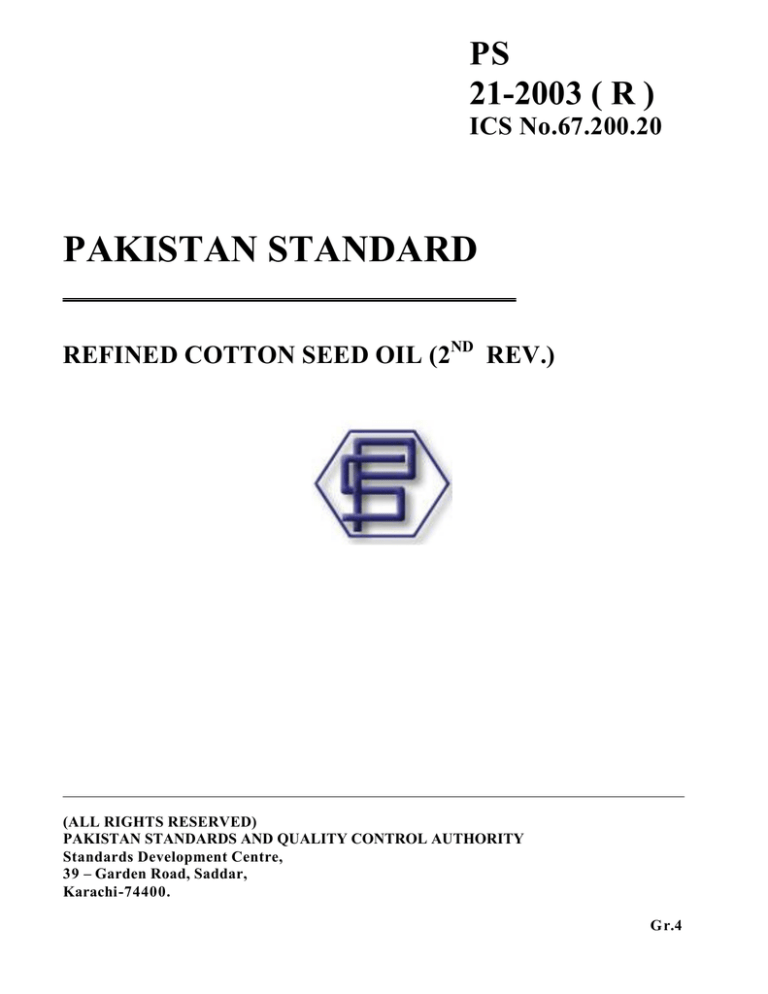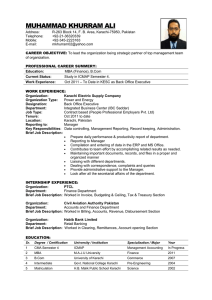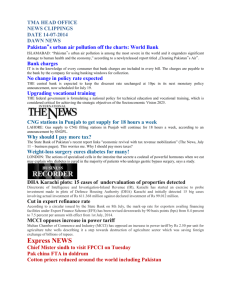
PS
21-2003 ( R )
ICS No.67.200.20
PAKISTAN STANDARD
REFINED COTTON SEED OIL (2ND REV.)
(ALL RIGHTS RESERVED)
PAKISTAN STANDARDS AND QUALITY CONTROL AUTHORITY
Standards Development Centre,
39 – Garden Road, Saddar,
Karachi-74400.
Gr.4
PS:21-2003 ®
PAKISTAN STANDARD SPECIFICATION
FOR
REFINED COTTON SEED OIL (2 ND REV.)
OILSEEDS & THEIR ALLIED PRODUCTS SECTIONAL
COMMITTEE.
CHAIRMAN
1.
Dr. Abid Hasnain
Chairman,
Deptt. of Food Technology,
University of Karachi,
KARACHI.
MEMBERS
2.
Mr. Muhammad Saleem,
Chief, Nutrition Division,
National Institute of Health,
ISLAMABAD.
3.
Surgeon General,
AGS Branch (Med Dte),
GHQ,
RAWALPINDI.
4.
Director General,
PCSIR Laboratories Complex,
Off, University Road,
KARACHI.
5.
Director,
Quality Control Centre (PSQCA),
Block No.77, Pak Secretariat,
KARACHI.
6.
Mr. Haq Nawaz Bangash,
Govt. Public Analyst,
Food Laboratory,
Laedy Reading Hospital,
PESHAWAR.
7.
Govt. Public Analyst,
Food Laboratory,
HYDERABAD.
8.
Mrs. Kishwar Shabina,
Public Analyst.
KMC Food Laboratory,
KARACHI.
i
PS:21-2003 ®
9.
Mr. Anwaruddin Qazi,
Incharge,
KMC Food Laboratory
KARACHI
10.
Chairman,
All Pakistan Fats & Oil Importers,
KARACHI.
11.
Miss Ghazala Sultana,
Senior Microbiologist,
Agriculture & Livestock Products
Marketing & Grading Deptt.,
Test House, M.T. Road,
KARACHI.
12.
Mr. Saleem Chohan,
Managing Director,
Trading Corporation of Pakistan Ltd.,
Press Trust House, I.I. Chundrigar Road,
KARACHI.
13.
Director General,
Agricultural Research Institute,
Ternab,
PESHAWAR.
14.
Mr. Umer Farooq Hashmi,
Manager Quality Assurance,
Lever Brothers Pakistan Ltd.,
Awari Plaza, Fatima Jinnah Road,
KARACHI.
15.
Secretary,
Pakistan Vanaspati Manufacturers
Association,
ISLAMABAD.
16.
Director,
Oilseeds Research Institute,
FAISALABAD.
17.
Director General,
Agricultural Research Institute,
TANDOJAM.
18.
Mr. Arshad Karim Bhatti,
Rafhan Best Foods Ltd.,
Shapur, Multan Road,
LAHORE.
19.
Chairman,
Pakistan Cooking Oil Manufacturers
Association,
LAHORE.
20.
Director General,
M/s. Punjab Cooking Oil Mills Ltd.,
Khanewal Road,
KABIRWALA.
21.
General Manager,
United Industrial Ltd.,
101, First Floor, Regency Arcase,
FAISALABAD.
ii
PS:21-2003 ®
22.
Mr. Nizar G. Hussain,
Chairman,
Agro Processors & Atmospheric
Gases (Pvt.) Ltd.,
KARACHI.
23.
Mr. Ahsan Ali Shah,
Wazir Ali Industries,
Hali Road,
HYDERABAD.
24.
Dr. Ehsanullah,
S.S.O.,
Food Technology Research Lab.,
Pak. Agri. Research Council,
ISLAMABAD.
25.
Mr. Iftikhar Ahmed,
Malaysian Palm Oil Board,
KARACHI.
26.
Raja Bashir Ahmed,
General Manager,
Habib Cooking Oil Mills Ltd.,
KARACHI.
27.
Mr. Abdurauf Khan,
Managing Director,
Pakistan Oils Development Board,
ISLAMABD.
28.
Mrs. Raazia Shakir,
Export Advisory Cell,
Ministry of Industries & Prodution,
ISLAMABD.
29.
Ms. Izzat Afza Siddiqui,
Customs Laboratory,
Custom House,
KARACHI.
30.
Dr. M. Asad Hasan,
Director (Ex-Officio)
Pakistan Standards & Quality
Control Authority,
Standards Development Centre,
KARACHI.
SECRETARIAT
1.
Mr. Abdul Hayee,
Deputy Director (Agri. & Food) &
Secretary to the Committee,
Pakistan Standards & Quality
Control Authority,
Standards Development Centre,
KARACHI.
2.
Mr. Naseem-us-Sami,
Dy.Asstt. Director (Agri. & Food),
Pakistan Standards & Quality
Control Authority,
Standards Development Centre,
KARACHI.
___________________
iii
PS: 21-2003 ®.
PAKISTAN STANDARD SPECIFICATION
FOR
REFINED COTTON SEED OIL (2ND REV.).
0.
FOREWORD
01.
This Pakistan Standard was adopted by the Pakistan Standards & Quality Control Authority,
Standards Development Centre on 28th January, 2003, after the draft finalized by the Oil
Seeds &
their Allied Products Sectional Committee had been approved by the Agriculture & Food
Products
Divisional Council.
02.
This Pakistan Standard specification was originally adopted in 1993 keeping in view the latest
development the committee felt it to revise again.
0.3
This standard specification is based on data available on various varieties of Cotton Seed grown in
different parts of the country. It is used as a edible/vegetable oil after suitable refining and
deodorization and is also used in the manufacture of hydrogenated vegetable oil products.
0.4
In preparation of this standard, the views of the manufacturers, technologists and testing authorities,
etc. have been taken into consideration.
0.5
The final value expressing the results of a test or analysis shall be rounded off in accordance with
PS:103-1991 (1st Rev.) “Methods of Rounding Off Numerical Values”. The number of significant
places retained in, the rounded off value shall be the same as that of the specified value in the
standard.
1.
SCOPE
1.1
This standard prescribes the requirements and methods of sampling and test for refined Cotton Seed
Oil.
2.
TERMINOLOGY
2.1
For the purpose of this standard the following definition in addition to the definitions given under 2
of PS:56-1996 Methods of Sampling & Test for Vegetable Oil (1st Rev.) shall apply.
2.1.1
Refined Cotton Seed Oil shall be obtained by Chemical or Physical refining, bleaching and
deodorization. The final products shall be free from harmful chemicals.
1
PS:21-2003 ®
3.
REQUIREMENTS
Description – The material shall be obtained from the seeds of various cultivated species of
Gossypium by a process of solvent extraction or by a process of expression or any other suitable
process.
3.1
i.
ii.
iii.
iv.
v.
vi.
vii.
viii.
The material shall be clear and free from adulterants, sediments suspended and other foreign matter,
separated water and shall have acceptable taste and odour. It may contain antioxidants and synergist
as follows :
ANTIOXIDANTS
MAXIMUM LEVEL OF USE
Propyl octyl, and dodecyl
gallates
Butylated hydroxy-toluene (BHT)
Butylated hydroxyanisole (BHA)
Any combination of gallates
with BHA, or BHT both.
Natural & Synthetic tocopherols
Ascorbyl palmitate or in combination.
Ascorbyl stearate
100 mg/kg individually
or in combination.
200, mg/kg individually
or in combination.
200 mg/kg but gallates not
to exceed 100 mg/kg.
Not limited
200 mg/kg individually
200 mg/kg individually or in
combination.
200 mg/kg
200 mg/kg.
Dilauryl thiodirodionate
Tertiary Butly Hydroquinone
(TBHQ).
ANTIOXIDANT SYNERGISTS
MAXIMUM LEVEL OF USE
i.
ii.
iii.
Citric acid & its sodium salt
Isopropyl Citrate mixture
Phosphoric acid
Limited by GMP.
100 mg/kg
100 mg/kg individually or in
combination.
3.2
Colour – Only the natural colour should be used where necessary and the container should be
labelled accordingly.
Flavour – Natural flavours and their identical synthetic equivalents, except those which are known
to represent a toxic hazard and other Synthetic flavours approved by the Codex Alimentarius
Commission are permitted for the purpose of restoring natural flavour lost in processing or for the
purpose of standardizing flavour, as long as the added flavour does not deceive or mislead the
consumer by concealing damage or inferiority or by making the product appear to be greater than
actual value.
3.3.1
Use of the following solvents in flavour is prohibited :
i.
ii.
Diethylene glycal Mono ethyl ether.
Isopropyl alcohol.
2
PS:21-2003 ®
3.3.2
When natural flavour or artificial flavour shall be used, the container shall be labeled with legend
“Contains natural flavour or synthetic flavour”.
3.3
The clarity of the material shall be judged by the absence or turbidity after keeping the filtered
sample at 35 0 C for 5 hours.
3.4
Turbidity – Admixture with other oils – The materials shall be free from mixture with mineral or
other oils of vegetable or animal origin when tested according to the method, prescribed in
PS:56 – 1996.
3.5
The material shall also comply with the requirements given in Table – 1.
4.
PACKING AND MARKING
4.1
The product shall be packed in suitable sealed and well closed containers made from food grade
material in accordance with PS:4797-2002 for Flexible Packs for the Packing of Banaspati, Cooking
Oil and Edible Oils or Plastic container made from Food Grade plastic or in accordance with
PS:4773-2002 for Tinplate Containers for Ghee, Banaspati, Cooking Oil/Edible Oils.
4.2
The weight of tin container for packing of Cotton Seed Oil shall be as follows :
WEIGHT OF FINISHED PRODUCT
WEIGHT OF TIN CONTAINERS
16 Litre
10 Litre
5 Litre
2.5 Litre
4.3
880 g
660 g
330 g
180 g
to
to
to
to
890 g
670 g
340 g
190 g
MARKING
The container shall be marked with the following particulars :i.
ii.
iii.
iv.
v.
vi.
vii.
viii.
ix.
x.
Name of the material in Block letter, e.g. REFINED COTTON SEED OIL
Date of manufacture and Date of expiry.
(PS:4449-1999 Expiration periods for food product shall be strictly followe).
Name and address of manufacturer.
Net volume of the contents in litre.
Chemical parameters & their value should be displayed on the label., like Moisture, Iodine
Value, Peroxide Value, FFA and Colour etc.
The words contains 33000- I.U. ± 10 % (Assay variation) of Vitamin-A per kg of the
finished product when packed.
Pakistan Standard Number and PS Mark.
Licence Number.
Storage conditions.
3
PS:21-2003 ®
5.1
No label, declaration methods of preparation and publicity concerning the product, shall be made in
a manner likely to mislead the purchaser and/or consumer as to the true nature/or composition of the
product as a whole.
TABLE – 1
REQUIREMENTS FOR REFINED COTTON SEED OIL (2ND REV.)
SL:
NO.
i.
ii.
iii.
iv.
v.
vi.
vii.
viii.
ix.
CHARACTERISTIC
LIMITS
Moisture and insoluble impurities percent
by weight, max.
Colour in a 5¼ inch cell on
lovibond scale.
Refractive index at 40 0C.
Relative density (20 0C/Water at 20 0C)
Saponification value.
Iodine Value (Wijs).
Unsaponifiable matter, percent by
weight, max.
Peroxide value, expressed as
milliequivalent oxygen per kg. Max.
Anisidine Value max / Rancidity
(Kries Test) ****, max.
0.15
R– 5
Y – 50
1.4580 to 1.4660
0.910 to 0.921
189 to 198
100 to 115
1.5
12
10.0
20
3.0 R
See Appendix-C
of PS:221-2003
(3rd Rev.)**
23
x.
Vitamin-A
xi.
Cloud point, max.
xii.
xiii.
Free Fatty Acid. (as oleic acid) percent by
weight, max.
Helphen Test1
Positive
xiv.
Soap content., ppm, max.
50
*
**
***
33000 I.U. ± 10%
(Assay variation) per kg
of the finished product
10 0C
0.2
Methods of Sampling & Test for Vegetable Oils and Fats.
ISO-3015-1992 Petroleum Oil Determination of cloud point.
Banaspati Ghee (1st Rev.).
4
REF. TO
CLAUSE OF
PS:56-1996*
4
9
10
14
13
7
PS:ISO:30151992**
6
See Vol.13 of Codex
Alimentarius.
Appendix-D of
PS:221-2003 (3rd
Rev.)***
PS:21-2003 ®
**** Colour produced in Kries Test shall be interpreted alongwith Peroxide Value and shall be
sensory test as negative. If the colour is not deeper than 3.0 R 1 inch cell lovibond scale.
1
Kapok Oil and some other oils give a positive test and fats from Animals fed on cotoon
seed meal may also give a positive test. Different lots of Cotton Seed Oil may react with different
intensities. Hydrogenation and heating of Cotton Seed Oil reduce the intensity of the
reaction and may destroy it entirely.
6.
SAMPLING
Representative samples of the material shall be drawn as prescribed under PS:56-1996.
7.
TEST METHODS :
Test should be carried out in accordance with the methods prescribed in PS:56-1996.
Quality of Reagents – Unless specified otherwise analytical grade chemicals and distilled
water (PS:593 –1991) shall be used in test.
NOTE – Analytical grade chemicals shall mean chemicals that do not contain impurities which
affect the results of analysis.
____________________
Printed at Pakistan Standards and Quality Control Authority Press.
5




